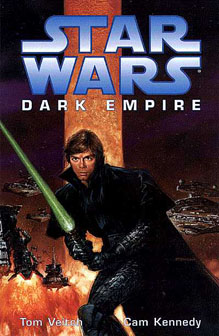“Dark Empire” (1991-92) has always been in the shadow of the “Thrawn Trilogy” novels (1991-93). Both came out about the same time, and both are spot-on continuations from “Return of the Jedi” — but in different ways. Re-reading the six-issue “Dark Empire” series recently, though, it’s clear that it has been savaged by redrawn continuity much more than the novels of the same time.
Anecdotally, “Dark Empire” seems to be respected less than the “Thrawn Trilogy” by fans. I’m guilty of this, too. I discovered both at the same time — in April 1992. I pinpointed the date because that’s when the first printing of Issue No. 4 came out, and that was on the shelves when my dad traded in his vintage comic collection for store credit at a comic-book store and I got a ton of “Star Wars” toys, plus “Heir to the Empire” and “Dark Empire” No. 4 (In past blogs, I mistakenly said I discovered “Heir” in 1991, the year of its publication, but I was actually a bit of a “Star Wars” literature laggard back in that pre-Internet age). I responded to the layers of Timothy Zahn’s novels and saw “Dark Empire” as “just a comic book,” one where Cam Kennedy’s (gorgeous, I now realize) artwork immediately painted it as darker than my usual tastes.
Although both projects came about simultaneously, there was no compromise between the writers — Tom Veitch magnanimously re-adjusted his story to accommodate Zahn’s. The set-up for “Dark Empire” is that the galaxy devolved into a three-way civil war after the death of the Emperor — a couple of Imperial factions, plus the New Republic, which is often still referred to as the Rebel Alliance here. The two Empire factions are warring on Coruscant (Imperial City) and the other major worlds (known as the Imperial System here). Originally, Veitch envisioned this as taking place immediately after “Jedi”; indeed, it would’ve made sense there, in the political and military chaos after the Emperor’s death.
In deference to Zahn’s work, which put Luke at the same level of Jedi-hood as the last time we saw him on-screen, Veitch and Dark Horse smartly moved this series to the year AFTER the “Thrawn Trilogy” (six years after “Jedi”), making Han and Leia into a married couple and having Leia be pregnant with her third child. (Of course, in future stories, Zahn would have to acknowledge the events of “Dark Empire,” but he seems dismissive of the idea of the resurrected clone Emperor when he addresses it in “Vision of the Future”: “Personally, I’m not convinced it was really him,” says former Emperor’s Hand Mara Jade.)
Thematically, however, “Dark Empire” works in this timeline position. Admittedly, it’s very odd that we never see the Empire’s re-taking of Coruscant between “The Last Command” and “Dark Empire” No. 1 in any books or comics (I understand that a West End Games roleplaying guide chronicles it). So that’s certainly a clunky relic of the originally devised timeline placement.

But I like the thematic idea that the New Republic will never be stable until it has the foundation of a new Jedi Order. This is the series where Luke comes to that realization (In the final panel of the series, he tells Leia: “I feel it, great things are coming. The Jedi Knights will rise again.”). That notion segues nicely into Kevin J. Anderson’s “Jedi Academy Trilogy” of books. (Although there would be a six-issue “Dark Empire II” and a two-issue “Empire’s End,” those don’t affect the thematic hand-off from Veitch to Anderson.)
I like the way Veitch tells this story: Tightly plotted, film-style action, with details fleshed out in text in the back of each issue (some of this material is essentially a sneak-preview of “Tales of the Jedi”). The dialog sparkles, including little character moments like C-3PO showing concern for R2-D2.
A lot of minor continuity elements have been scrapped since “Dark Empire’s” publication (the planet Calamari is now known as Mon Cala), but mostly none of this is Veitch’s fault — he couldn’t see the future or read George Lucas’ mind. The Emperor tells Luke he has transferred his essence into clones many times, but that element hasn’t been brought into any stories written since, and the official ret-con is that Palpatine simply lied to Luke.
Some mistakes are Veitch’s fault: He has General Dodonna still be alive despite his death in the “Star Wars” newspaper strips. However, that was smoothly ret-conned — he was only believed to be dead — and Dodonna would have more of a role to play in Michael Stackpole’s “X-Wing” series. (That series, by the way, fills the timeframe that “Dark Empire” was originally planned for — post-“Jedi” but pre-“Thrawn Trilogy.”) And some mistakes are simply mistakes: Veitch writes in his background text for issue No. 3: “Mako and Han were (Imperial Academy) classmates, in the years before the Clone Wars.” That timeline gaffe can only be answered with a “Whoops!”
When Veitch’s ideas do mesh with Lucas’ future revelations, it’s very cool. Foremost is the concept that the galaxy-wide power of the Force fluctuates between light and dark (Mace and Yoda noticed their power diminishing in “Revenge of the Sith,” and Luke notices the Dark Side rising here, which is why he decides to infiltrate Palpatine’s sanctum). Although it’s simpler, or perhaps BECAUSE it is simpler, I prefer Luke’s “joining the Dark Side in order to destroy it” yarn more than Ulic Qel-Droma’s in “Tales of the Jedi.” Luke — whom Kennedy portrays as hooded, dark-eyed and scary — is an intriguing cipher here, and as a reader I tend to agree with Han:
“Luke doesn’t want any help. He says he wants to do it alone, and I believe him. Besides, you know me, I’m not about to challenge the judgment of a Jedi.”
My favorite “Dark Empire” invention is the Jedi Holocron (it would be pluralized in future yarns, although it seems Veitch envisioned that there was only one) — essentially, a search engine of Jedi history. Palpatine shows it to Leia:
“This is the Jedi Holocron. Given to me many years ago by a very old Jedi, before his untimely demise.”
Oh, how cool it would’ve been if Veitch had left it at that! Then we could’ve assumed Palpatine took it from his master, Darth Plagueis. In the notes, though, it says Palpatine killed a Jedi named Ashka Boda and stole it.
Secondarily, I enjoy the detour to Han’s homeworld, the Smuggler’s Moon Nar Shaddaa. We meet Han’s old girlfriend, Salla Zend, and this re-reading really made me appreciate how well A.C. Crispin fleshed out that relationship in her “Han Solo Trilogy” based on the hints here — everything syncs beautifully. Also, Veitch resurrects Boba Fett with a rare explanation that isn’t fleshed out in the notes, although it’s still the coolest line in “Star Wars” comics history: “The Sarlacc found me somewhat indigestible, Solo.” (“Tales from Jabba’s Palace” and “Tales of the Bounty Hunters” would tell the story.)
Thirdly, I like the notion of the Deep Core Worlds, including the Emperor’s throne world of Byss, which are steeped in darkness. This foreboding environment may have been a turn-off when I first read these comics as a kid, but it makes sense: After all, there had to be someplace off the beaten path where the Emperor hung out for six years after his on-screen death.
If memory serves, the storytelling quality drops off in “Dark Empire II” and “Empire’s End” (I mean, World Devastators and super-massive-huge-black Star Destroyers are one thing, but a Galaxy Gun? Ugh.). But we shall see; I’ll review those series in future flashbacks.
For now, what are your thoughts on the original “Dark Empire?” Does it deserve appreciation on the level of the “Thrawn Trilogy” or do its daring oddities — Luke joining the enemy, Palpatine being alive, the usurping of the New Republic government happening in the opening crawl rather than on-page — make it more of a curiosity than an essential chapter?

